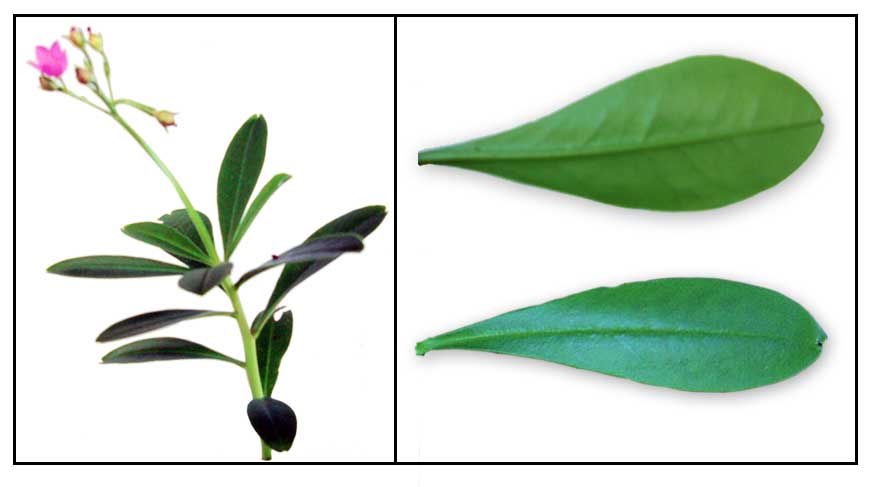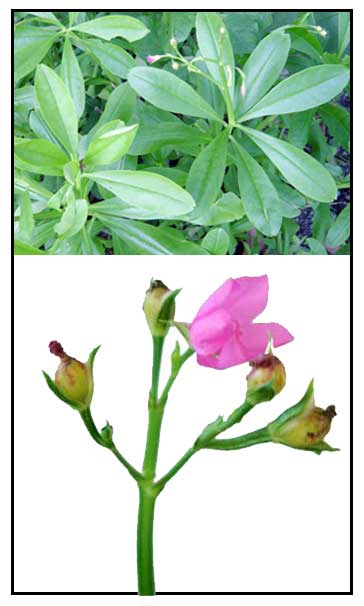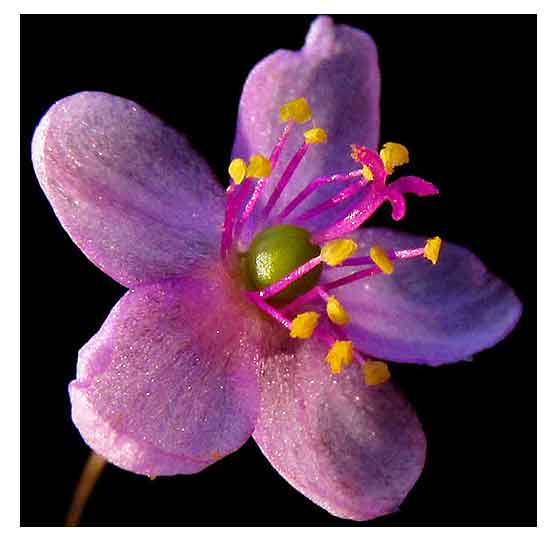 Gen info Gen info
- English common name might have
been taken from the title of a novel by American writer Edgar Rice Burroughs,
Tarzan and the Jewels of Opar. (5)
Another makes a reference to the ancient African city from which frankincense
and gold were hauled by caravan to Solomon's treasure.
 Botany Botany
• Talinum is a fleshy, erect herb, growing
up to 100 to 120 centimeters tall. Roots are swollen and fleshy. Stems are succulent, slightly woody at the base. Leaves are in whorls, obovate-lanceolate, flat, glossy and
bright green. Flowers are in terminal panicles, small and pink colored. Fruit is a globose, glossy, dark red capsule, 3 to 5 millimeters in diameter, many-seeded.
• Talinum paniculatum is often confused with Talinum fruticosum. NatureLoveYou suggests this differentiating point, based on sepal and flower size. Based on the description in PIER (Pacific Island Ecosystems at Risk) website, the sepals of T. paniculatum is 2-4 mm long while that of T. fruticosum is 4-5 mm long. It is therefore quite clear that the one with small flowers should then be T. paniculatum. (23)
Distribution
- Introduced.
-
A garden plant or ornamental hedge.
- In some places, has escaped the gardens to become weeds.
- Native range is tropical and subtropical America. (4)
- Now pantropic
Constituents
- Root has saponin, steroid
and essential oil.
- Phytochemical screening of hexane and ethyl acetate extracts yielded potassium nitrate (1); a mixture of long chain hydrodrocarbons [hentriacontane (2), dotriacontane (3), tritriacontane (4) and pentatriacontane (5)]; heneicosanoic acid (6); the ester nonacosyl nonacosanoate (7); urea (8); 3-O-β-D- glucosyl-β-sitosterol (9); the mixture of β-sitosterol (10) and stigmasterol (11), and a pentacyclic triterpene 3-O-acethyl-aleuritolic acid (12). (See study below) (8)
- Methanolic leaf and root extracts yielded various phytosterols: campesterol, ß-sitosterol, stigmasterol, stigmastan-3-ol, stimast-22-en-3-ol and stigmastanol.
(See study below) (9)
-
Study of root identified a mixed compound of 1-hexacosanol, 1-octacosanol and 1-triacontanol, its acetate, and a mixed compound of campesterol, stigmasterol, and ß-sitosterol together with ß-sitosteryl-ß-D-glucoside. (15)
Properties
- Leaves considered cooling, emollient, antiscorbutic, saponin, alterative, vulnerary, and resolvent.
- Studies have suggested antinociceptive, anti-edematogenic, phytoremediative, anti-fertility, estrogenic, tocolytic, anti-aging, immunomodulatory, anti-rheumatoid arthritis, antioxidative, antibiotic synergism, aphrodisiac, cardiorenal, diuretic, hypoglycemic, spermatogenic properties.
Parts used
Leaves and roots.
 Uses Uses
Edibility
- Young leaves and stems are used as vegetable.
- Leaves used as salad ingredient.
- Shoots and leaves added to stews and soup.
-
Author's mother told of a time during WWII when the leaves were used as food in times of scarcity.
- In some parts of Asia, used as a spice.
Folkloric
- In Asian traditional medicine, use extensively as a reproductive tonic.
- Roots used as substitute for ginseng.
-
Used to regulate menses; also, for cough, general debility, diarrhea.
- In China, it is cultivated as a medicinal
herb. In traditional Chinese medicine, the herb is used as a substitute for Ginseng.
- In Indonesia, used for liver and kidney
problems.
- In Brazil, plant used to treat inflammatory conditions. Used as aphrodisiac, to treat gastrointestinal disorders, and as cardioprotective agent.
- Used to treat bad smelling urine, enuresis, irregular menses, gastrointestinal disorders, general debility. Leaves used topically in the treatment of edemas, skin inflammation, minor scratches, cuts, and scrapes. Decoction of roots used to treat scurvy, arthritis, stomach inflammation, and pneumonia. (8)
- Popular in Thai herbal recipes for enhancing vitality, treating diabetes, inflammatory skin problems, GI troubles, and general weakness. Used to induce lactation and restore uterine functions postpartum. (10)
- Swollen root used as aphrodisiac.
Studies
• Octacosanol : Octacosanol has been isolated
from the roots of Talinum paniculatum. Octacosanol is being investigated in humans for use
as an antiviral for herpes and for the treatment of inflammatory skin
diseases. It may be helpful with Parkinson's disease, amyotrophic lateral sclerosis, heart disease and cholesterol reduction. (1)
• Constituents: From the roots, study yielded a mixed compound of 1-hexacosanol, 1-octacosanol and 1-triacontanol, its acetate, and a mixed compound of campesterol, stigmasterol, and B-sitosteryl-B-D-glucoside. (2)
• Estrogenic Activity / Roots and Leaves: Study explored the estrogenic activity of T. paniculatum root and leaf extracts compared with 17ß-estradiol (E2) in an experimental model of menopause in adult bilaterally ovariectomized (OVX) rats. Results showed T. paniculatum possess estrogenic activity in the OVX rats, which can be helpful in naturally managing reproductive tissues regression during menopause via an herbal option without any toxicity. (7)
• Antinociceptive / Anti-Edematogenic: Study evaluated crude extracts for anti-edematogenic and antinociceptive activities in a formalin-induced paw edema model. Hexane and ethyl acetate extracts showed higher anti-edematogenic and antinociceptive activity. (See constituents above) (8)
• Anti-Fertility / Anti-Implantation / Abortifacient / Roots and Leaves: Study of methanolic root and leaf extracts in female Wistar rats showed significant estrogenic activity, with anti-implantation activity and early abortifacient activity in a dose dependent manner. (9)
• Tocolytic / Effects on Uterine Contractility: Study investigated the effects of T. paniculatum leaf extracts on uterine contractility on adult female virgin rats. Results showed that spontaneous uterine contractile activity were dose-dependently inhibited by the leaf extracts. Results suggest T. paniculatum produces tocolytic effects on both spontaneous and agonist-induced contractions, possibly due to blockade of Ca2+ influx via L-type Ca2_ channel and Ca2+ efflux from internal store. (10)
• Phytoremediation / Iron: Study investigated the effectiveness of T. paniculatum as a phytoremediator for Fe in lateritic soil. Results showed higher amounts of Fe in the leaves grown in 75% and 100% lateritic soil and suggests potential use as phytoremediator and guide with regards its edibility. (11)
• Ginseng Jawa / Effect on Hippocampus Pyramidal Lamina Thickness: Study evaluated the effect of Ginseng Jawa (T. paniculatum) root on the thickness of CA1 pyramidal lamina of the hippocampus. Ginseng Jawa (Talinum paniculatum Gaertn.) with similar component to Panax ginseng, is assumed to have the same effect to the memory processing in the brain especially in the hippocampus neuron. Results showed GJ root administered orally increases the thickness of pyramidal lamina CA1 of the hippocampus. (12)
• Antioxidative / Anti-Aging: Study investigated the antioxidative and anti-aging effects of extracts from Talinum paniculatum. Leaf and stem extracts showed free radical scavenging effects and superoxide radical scavenging effects. Photoprotective potential of LSE was tested in HDF (human dermal fibroblast) exposed to ultraviolet irradiation. Results showed the LSE have anti-aging effects and the plant can be used as a source of new functional materials against oxidative stress-mediated skin damages. (13)
• Effect of Java Ginseng in Fitness of Male White Rat: Study investigated the process of improving fitness and its correlation with Java ginseng dose. The root of the plant is widely used as a substitute for Korean ginseng root. Results showed Java ginseng extract can increase the maximum ability to swim longer and reduce the oxidative stress evidenced by a decrease in malondialdehyde (MDA) levels. (17)
• Extraction of Flavonoids / Antioxidant Activity: Study reports on the microwave assisted extraction of flavonoids from T. paniculatum and its oxidation resistance, reporting on ethanol concentration, material liquid ration, extraction temperature and time, microwave power and time. Flavonoid yield could be 11.42%, more than 0.62% higher than conventional extraction. (18)
• Antibacterial / Antifungal / Leaves: Study evaluated various extracts and fractions of T. paniculatum leaves for antimicrobial and antimycobacterial activity. The LE showed activity against Serratia marcescens and Staphylococcus aureus with MICs of 250 and 500 µg/mL, respectively. A hexane extract showed good activity against Micrococcus luteus and Candida albicans. Although the crude leaf extract showed low MIC against S. aureus, further studies are suggested to investigated the possible synergism between T. paniculatum and antibiotics used to treat resistant strains (MRSA). (19)
• Antibacterial / Leaves:Study evaluated the in vitro antibacterial activity and MICs of various leaf extracts of Talinum paniculatum against E. coli (ATCC 25922) and S. aureus (ATCC 25923). A crude leaf extract exhibited against both E. coli and S. aureus. Study concludes the antibacterial potential of leaves of TP is mediated primarily by its phytoconstituents (alkaloids, phenols, saponins, tannins, steroids, triterpenes and flavonoids) which hinder peptidoglycan synthesis in bacterial cell wall, destroy bacterial membrane, alter surface hydrophobicity, alter cell signaling pathways and modulate quorum sensing. (20)
• Synergistic Antimicrobial Activity with Antibiotics / Root:Study evaluated the effects of T. paniculatum in combination with tetracycline, erythromycin, and streptomycin against S. aureus and E. coli. The root extract statistically enhanced the activity of all the antibiotics against S. aureus. However, it showed no synergistic activity against E. coli. (21)
• Antioxidant / Polysaccharides / Stem: Study reported on the ultrasonic extraction of polysaccharides from Talinum paniculatum and evaluated the antioxidant activity using DPPH, hydroxyl radical, and superoxide radical assays. The stem polysaccharides exhibited powerful antioxidant. (22)
• Cardiorenal Effects / Diuretic Effect: Study evaluated the cardiorenal properties of ethanol soluble fraction from T. paniculatum (ESTP). The diuretic and hypotensive potential of ESTP at doses of 30, 100, and 300 mg/kg were investigated in male rats, along with evaluation of possible effects on peripheral vascular resistance. Chemical compounds from ESTP included chlorogenic acids, amino acids, nucleosides, O-glycosylated flavones and organic acids. No signs of toxicity and no changes in urine volume or electrolyte elimination were observed after ESTP acute treatment. However, prolonged treatment significantly increased urine volume and electrolyte excretion (Na+, K+, and Cl-) without effect on blood pressure or heart rate. The effects are involved with activation of small conductance calcium-activated potassium channels contributing to increase renal blood flow and glomerular filtration rate. (24)
• Anti-Candida / Chewable Lozenges / Leaves: Study evaluated the antifungal activity of T. paniculatum towards Candida albicans using chewable lozenges formulated from Som Jawa leaves extract. Physical properties tested included included organoleptic testing, weight uniformity, hardness, elasticity, friability, chewiness, and moisture content. Results showed a 50% concentration can inhibit the growth of C. albicans with zone of inhibition of 22.69 mm. Organoleptic results showed the lozenge to be odorless, brown, and chewy. Results suggested potential for the formulated chewable lozenges as alternative topical therapy. (25)
• Cardioprotective / Doxorubicin Toxicity /-Candida / Chewable Lozenges / Leaves: Study evaluated the effect of ethanolic extract of T. paniculatum (EETP) in rats with renovascular hypertension and heart failure in Wistar rats. The model of renal hypertension was induced by Goldblatt 2K1C method and intraperitoneal doxorubicin administration for six weeks. Results suggest EETP may exert cardioprotective effects through serum antioxidant activity and angiotensin converting enzyme (ACE) inhibition, preventing alterations of hemodynamic and endothelial function, and reducing damage to cardiac structure. The EETP at doses of 100 and 300 mg/kg may be useful in preventing doxorubicin-induced cardiotoxicity in hypertensive patients. (26)
• No Effect on Pubertal Development / Leaves: Study evaluated the effects of ethanol-soluble fraction of T. paniculatum leaves (ESTP) on general toxicity and on pubertal development of male and female Wistar rats with 30-day treatment of 30 or 300 mg/kg, using uterotrophic and pubertal assays. The ESTP treatment did not promote estrogenic effects in female rats, with no daily signs of toxicity or weight loss in pubertal testing. ESTP did not affect the onset of vaginal opening and preputial separation and caused no changes in biochemical parameters, organ weight, and histopathological analysis. (27)
• Anti-Inflammatory / Leaves: Study evaluated the anti-inflammatory effects of T. paniculatum leaf extracts in rats. Results showed the water extract of leaves had an anti-inflammatory effect not significantly different from the prednisone control group. The leaves contained secondary metabolites such as flavonoids, steroids, and tannins known to have anti-inflammatory effects. (28)
• ß-Amyrin Synthase Gene / Leaves: Study isolated the probably gene encoding ß-amyrin synthase (bAS), a key enzyme involved in the cyclization of 2,3-oxidosqualne producing the backbone of the oleanane-type saponin ß-amyrin and aimed to characterize the gene sequence and the predicted protein sequence using in silico approach. A second aim was to analyze the correlation between the TpbAS gene expression level and saponin production in various plant organs. Analysis of TpbAS expression and saponin content showed saponin is mainly synthesized and accumulated in leaves. Findings will assist in increasing the saponin content through a metabolic engineering approach. (29)
• Aphrodisiac / Leaves: Study evaluated the effect of leaves extract of Java ginseng as aphrodisiac monitoring sexual behavior and libido testing in Wistar rats. Female wistar rats were administered ethynyl estradiol (EE2) and medroxyprogesterone, except for negative control. Drug-aroused sexual desire and leaves extract of Java ginseng (equal to 55 mg/drug powder) were administered to male rats. Results showed the leaves extract of Java ginseng can arouse sexual behavior of male rats, with reduction in mounting latency. (30)
• Anti-Rheumatoid Arthritis / Immunomodulatory / Leaves: Study evaluated the immunomodulatory effects of ethyl acetate leaf extracts on rheumatoid arthritis in Wistar rats. Results showed the ethyl acetate extract of leaves has an anti-rheumatoid arthritis effect. The three doses of 0.05, 0.1 and 0.15 g/kbw were effective in reducing the arthritis index. Decrease in CFA (Complete Freund's Adjuvant)-induced rat foot volume and arthritis index was attributed to the presence of saponins, flavonoids, and tannins in the leaves of T. paniculatum, which were able to modulate the immune system which played a role in rheumatoid arthritis. (31)
• Antidiabetic / Hypoglycemic / Roots: Study evaluated the antihyperglycemic effect of Javanese ginseng root on alloxan-induced male Rattus norvegicus rats. Infusion of ginseng root was administered via enteral feeding tube. Results showed a significant difference (p=0.0001) in delta blood glucose among the groups. Treatment group delta blood glucose (-102.99 mg/dL) was significantly greater than placebo (2.45), positive control (3.05), and negative control (1.60). The Javanese ginseng root showed potential as hypoglycemic agent in alloxan-induced diabetic animal models. (32)
• Effect on Spermatozoa Quality / Leaves: Study evaluated the effect of Javanese ginseng leaf extract of testicular weight and spermatozoa quality in mice. Parameters observed were testicular weight, amount, motility, viability, morphology of male mice cauda epididymis spermatozoa. Ethanol extract of leaves was administered to mice by gavage for 16 days. Results showed increase in testicular weight, type A motility, viability, and amount of spermatozoa, with no significant difference in morphology. Most effective dose of leaf extract was 7.7mg/20mg (treatment P3). (33)
• Effect of Selenium on Growth and Physiological Characteristics: Study evaluated the effect of selenium on the growth of ginseng and selenium-enriched Talinum paniculatum growth, photosynthetic pigment content, and selenium accumulation with selenium application (0, 2.5, 5, 10, 20 mg/kg). High concentration selenium (≥10 mg/kg) has significant effects on photosynthetic pigment content in leaves. Increase in selenium concentration increased the content of vitamin C. Selenium concentration distribution was root > leaf > stem. The root was the main part of selenium accumulation. The 5 mg/kg concentration is the best concentration for cultivating selenium-enriched T. paniculatum. (34)
Availability
- Wild-crafted.
- Seeds in the cybermarket.
|


 Gen info
Gen info Botany
Botany


